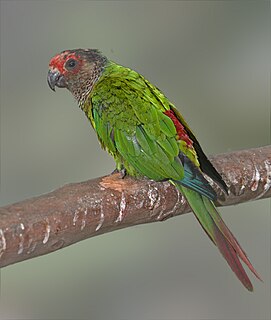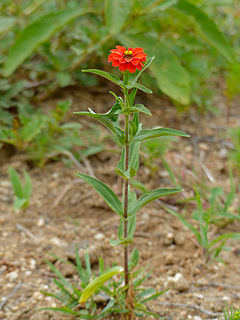
Physalis peruviana, a plant species of the genus Physalis in the nightshade family Solanaceae, has its origin in Peru. The plant and its fruit are commonly called Cape gooseberry, goldenberry, poha, and physalis, among numerous regional names. It has been cultivated in England since the late 18th century, and in South Africa in the Cape of Good Hope since at least the start of the 19th century. Widely introduced in the 20th century, P. peruviana is cultivated or grows wild across the world in temperate and tropical regions.

Echinopsis peruviana, the Peruvian torch cactus, is a fast-growing columnar cactus native to the western slope of the Andes in Peru, between about 2,000–3,000 m (6,600–9,800 ft) above sea level. It contains the psychoactive alkaloid mescaline as well as other alkaloids, although reported levels vary considerably and do not approach the concentrations found in Echinopsis pachanoi.

The coastal miner is a species of bird in the family Furnariidae. It is endemic to Peru.

The black-backed tanager is a species of bird in the family Thraupidae. It is endemic to forest and shrub into south-eastern Brazil. When first described it was mistakenly believed that it originates from Peru, leading to the misleading scientific name peruviana. It is closely related to the chestnut-backed tanager, and the two have sometimes been considered conspecific.

The rose-fronted parakeet, also known as the red-crowned parakeet, or, in aviculture, the rose-fronted conure, is a species of parrot in the family Psittacidae. It is found in the western Amazon basin in eastern Peru, far south-eastern Ecuador, north-western Bolivia and far western Brazil. It includes the wavy-breasted parakeet, also known as the wavy-breasted conure, which sometimes is considered a separate species.

Cascabela thevetia is a poisonous plant native throughout Mexico and in Central America, and cultivated widely as an ornamental. It is a relative of Nerium oleander, giving it a common name yellow oleander, and is also called lucky nut in the West Indies.
Cneoglossidae is a family of beetles, in the large suborder Polyphaga.

Zinnia peruviana, the Peruvian zinnia, is an annual flowering plant in the family Asteraceae. It is native to North America and South America.
Colobotheini is a tribe of longhorn beetles of the Lamiinae subfamily.

Colobothea is a genus of longhorn beetles of the subfamily Lamiinae.
Colobothea biguttata is a species of beetle in the family Cerambycidae. It was described by Bates in 1865. It is known from Brazil and Ecuador.
Colobothea bisignata is a species of beetle in the family Cerambycidae. It was described by Bates in 1865. It is known from Surinam, French Guiana, Guyana, Peru, Brazil, Ecuador.
Colobothea naevia is a species of beetle in the family Cerambycidae. It was described by Bates in 1865. It is known from Brazil and Ecuador.
Colobothea pictilis is a species of beetle in the family Cerambycidae. It was described by Bates in 1865. It is known from Brazil and French Guiana.
Colobothea pura is a species of beetle in the family Cerambycidae. It was described by Bates in 1865. It is known from Brazil.
Colobothea elongata is a species of beetle in the family Cerambycidae. It was described by Gahan in 1889. It is known from French Guiana and Brazil.
Colobothea plagiata is a species of beetle in the family Cerambycidae. It was described by Per Olof Christopher Aurivillius in 1902 and is known from Colombia.
Colobothea femorosa is a species of beetle in the family Cerambycidae. It was described by Erichson in 1847. It is known from Peru.
Colobothea fibrosa is a species of beetle in the family Cerambycidae. It was described by Erichson in 1847. It is known from Peru.
Colobothea varia is a species of beetle in the family Cerambycidae. It was described by Johan Christian Fabricius in 1787. It is known from Venezuela, Panama, and French Guiana.










